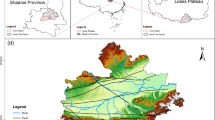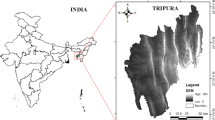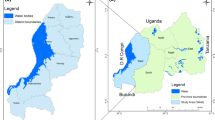Abstract
The purpose of the present study was to produce a landslide susceptibility map using analytic hierarchy process (AHP) model based on GIS for Gangu County, China. For this purpose, a detailed landslide inventory map was prepared and eight landside conditioning factors were considered, these factors were: slope angle, plan curvature, altitude, distance from faults, distance from rivers, distance from roads, rainfall, and lithology. The landslide inventory map was prepared by literatures, aerial photographs and field surveys, and a total of 328 landslides were identified in the study area. All landslides were applied for establishing the model and validating the model. The ArcGIS package was used to evaluate landslide susceptibility and analyze landslide conditioning factors, as a result, a landslide susceptibility map was generated using analytic hierarchy process model based on ArcGIS 10.0 and divided into five susceptibility classes: very low, low, moderate, high, and very high. Finally, In order to validate the accuracy of the landslide susceptibility map produced from AHP model, both physical and statistical methods were applied. The success rate curve results showed that the susceptibility map using AHP model has a success rate of 73.74 %. Therefore, the landslide susceptibility map will be helpful for landside hazard assessment and land use planning in the study area.





Similar content being viewed by others
References
Abella EC, Van Westen CJ (2007) Generation of a landslide risk index map for Cuba using spatial multi-criteria evaluation. Landslides 4(4):311–325
Akgun A, Sezer EA, Nefeslioglu HA, Gokceoglu C, Pradhan B (2012) An easy-to-use MATLAB program (MamLand) for the assessment of landslide susceptibility using a Mamdani fuzzy algorithm. Comput Geosci 38(1):23–34
Aleotti P, Chowdhury R (1999) Landslide hazard assessment: summary review and new perspectives. Bull Eng Geol Environ 58(1):21–44
Baeza C, Corominas J (2001) Assessment of shallow landslide susceptibility by means of multivariate statistical techniques. Earth Surf Proc Land 26(12):1251–1263
Bui DT, Lofman O, Revhaug I, Dick O (2011) Landslide susceptibility analysis in the Hoa Binh province of Vietnam using statistical index and logistic regression. Nat Hazards 59(3):1413–1444
Cevik E, Topal T (2003) GIS-based landslide susceptibility mapping for a problematic segment of the natural gas pipeline, Hendek (Turkey). Environ Geol 44(8):949–962
Chung CJF, Fabbri AG (2003) Validation of spatial prediction models for landslide hazard mapping. Nat Hazards 30(3):451–472
Clerici A, Perego S, Tellini C, Vescovi P (2002) A procedure for landslide susceptibility zonation by the conditional analysis method. Geomorphology 48(4):349–364
Clerici A, Perego S, Tellini C, Vescovi P (2006) A GIS-based automated procedure for landslide susceptibility mapping by the conditional analysis method: the Baganza valley case study (Italian Northern Apennines). Environ Geol 50(7):941–961
Dahal RK, Hasegawa S, Nonomura A, Yamanaka M, Masuda T, Nishino K (2008) GIS-based weights-of-evidence modelling of rainfall-induced landslides in small catchments for landslide susceptibility mapping. Environ Geol 54(2):311–324
Devkota KC, Regmi AD, Pourghasemi HR, Yoshida K, Pradhan B, Ryu IC, Althuwaynee OF (2013) Landslide susceptibility mapping using certainty factor, index of entropy and logistic regression models in GIS and their comparison at Mugling-Narayanghat road section in Nepal Himalaya. Nat Hazards 65(1):135–165
Grozavu A, Pleşcan S, Patriche CV, Mărgărint MC, Roşca B (2013) Landslide susceptibility assessment: GIS application to a complex mountainous environment. In: the carpathians: integrating nature and society towards sustainability. Springer: Berlin Heidelberg, pp 31–44
Guettouche MS (2013) Modeling and risk assessment of landslides using fuzzy logic. Application on the slopes of the Algerian Tell (Algeria). Arabian Journal of Geosciences 6(9):3163–3173
Hasekioğulları GD, Ercanoglu M (2012) A new approach to use AHP in landslide susceptibility mapping: a case study at Yenice (Karabuk, NW Turkey). Nat Hazards 63(2):1157–1179
Kayastha P, Dhital MR, De Smedt F (2013) Application of the analytical hierarchy process (AHP) for landslide susceptibility mapping: a case study from the Tinau watershed, west Nepal. Comput Geosci 52:398–408
Kundu S, Saha AK, Sharma DC, Pant CC (2013) Remote sensing and GIS based landslide susceptibility assessment using binary logistic regression model: a case study in the Ganeshganga Watershed, Himalayas. J Indian Soc Remote Sens 41(3):697–709
Lee S, Choi U (2003) Development of GIS-based geological hazard information system and its application for landslide analysis in Korea. Geosci J 7(3):243–252
Lee S, Min K (2001) Statistical analysis of landslide susceptibility at Yongin, Korea. Environ Geol 40(9):1095–1113
Lee S, Pradhan B (2006) Probabilistic landslide hazards and risk mapping on Penang Island, Malaysia. J Earth Syst Sci 115(6):661–672
Lee S, Pradhan B (2007) Landslide hazard mapping at Selangor, Malaysia using frequency ratio and logistic regression models. Landslides 4(1):33–41
Luzi L, Pergalani F, Terlien MTJ (2000) Slope vulnerability to earthquakes at subregional scale, using probabilistic techniques and geographic information systems. Eng Geol 58(3):313–336
Ma F, Wang J, Yuan R, Zhao H, Guo J (2013) Application of analytical hierarchy process and least-squares method for landslide susceptibility assessment along the Zhong-Wu natural gas pipeline, China. Landslides 10(4):481–492
Mezughi TH, Akhir JM, Rafek AG, Abdullah I (2012) Analytical hierarchy process method for mapping landslide susceptibility to an area along the EW highway (Gerik-Jeli), Malaysia. Asian J Earth Sci 5(1):13
Mondal S, Maiti R (2012) Landslide susceptibility analysis of Shiv-Khola watershed, Darjiling: a remote sensing and GIS based analytical hierarchy process (AHP). J Indian Soc Remote Sens 40(3):483–496
Nefeslioglu HA, Duman TY, Durmaz S (2008) Landslide susceptibility mapping for a part of tectonic Kelkit Valley (Eastern Black Sea region of Turkey). Geomorphology 94(3):401–418
Ozdemir A, Altural T (2013) A comparative study of frequency ratio, weights of evidence and logistic regression methods for landslide susceptibility mapping: Sultan Mountains, SW Turkey. J Asian Earth Sci 64:180–197
Pareek N, Sharma ML, Arora MK (2010) Impact of seismic factors on landslide susceptibility zonation: a case study in part of Indian Himalayas. Landslides 7(2):191–201
Parise M, Jibson RW (2000) A seismic landslide susceptibility rating of geologic units based on analysis of characteristics of landslides triggered by the 17 January, 1994 Northridge, California earthquake. Eng Geol 58(3):251–270
Park S, Jeon S, Choi C (2012) Mapping urban growth probability in South Korea: comparison of frequency ratio, analytic hierarchy process, and logistic regression models and use of the environmental conservation value assessment. Landscape Ecol Eng 8(1):17–31
Park S, Choi C, Kim B, Kim J (2013a) Landslide susceptibility mapping using frequency ratio, analytic hierarchy process, logistic regression, and artificial neural network methods at the Inje area, Korea. Environ Earth Sci 68(5):1443–1464
Park S, Choi C, Kim B, Kim J (2013b) Landslide susceptibility mapping using frequency ratio, analytic hierarchy process, logistic regression, and artificial neural network methods at the Inje area, Korea. Environ Earth Sci 68(5):1443–1464
Phukon P, Chetia D, Das P (2012) Landslide susceptibility assessment in the Guwahati city, Assam using analytic hierarchy process (AHP) and geographic information system (GIS). Int J Comput Appl Eng Sci 2:1–6
Poudyal CP, Chang C, Oh HJ, Lee S (2010) Landslide susceptibility maps comparing frequency ratio and artificial neural networks: a case study from the Nepal Himalaya. Environ Earth Sci 61(5):1049–1064
Pourghasemi HR, Pradhan B, Gokceoglu C (2012) Application of fuzzy logic and analytical hierarchy process (AHP) to landslide susceptibility mapping at Haraz watershed, Iran. Nat Hazards 63(2):965–996
Pourghasemi HR, Moradi HR, Aghda SF (2013) Landslide susceptibility mapping by binary logistic regression, analytical hierarchy process, and statistical index models and assessment of their performances. Nat Hazards 69(1):749–779
Pradhan B (2010) Landslide susceptibility mapping of a catchment area using frequency ratio, fuzzy logic and multivariate logistic regression approaches. J Indian Soc Remote Sens 38(2):301–320
Pradhan B, Lee S (2010a) Landslide susceptibility assessment and factor effect analysis: backpropagation artificial neural networks and their comparison with frequency ratio and bivariate logistic regression modelling. Environ Model Softw 25(6):747–759
Pradhan B, Lee S (2010b) Delineation of landslide hazard areas on Penang Island, Malaysia, by using frequency ratio, logistic regression, and artificial neural network models. Environ Earth Sci 60(5):1037–1054
Pradhan B, Youssef AM (2010) Manifestation of remote sensing data and GIS on landslide hazard analysis using spatial-based statistical models. Arabian J Geosci 3(3):319–326
Pradhan B, Singh RP, Buchroithner MF (2006) Estimation of stress and its use in evaluation of landslide prone regions using remote sensing data. Adv Space Res 37(4):698–709
Pradhan B, Mansor S, Pirasteh S, Buchroithner MF (2011) Landslide hazard and risk analyses at a landslide prone catchment area using statistical based geospatial model. Int J Remote Sens 32(14):4075–4087
Rautela P, Lakhera RC (2000) Landslide risk analysis between Giri and Tons rivers in Himachal Himalaya (India). Int J Appl Earth Obs Geoinf 2(3):153–160
Refice A, Capolongo D (2002) Probabilistic modeling of uncertainties in earthquake-induced landslide hazard assessment. Comput Geosci 28(6):735–749
Rowbotham DN, Dudycha D (1998) GIS modelling of slope stability in Phewa Tal watershed, Nepal. Geomorphology 26(1):151–170
Rozos D, Bathrellos GD, Skillodimou HD (2011) Comparison of the implementation of rock engineering system and analytic hierarchy process methods, upon landslide susceptibility mapping, using GIS: a case study from the Eastern Achaia County of Peloponnesus, Greece. Environ Earth Sci 63(1):49–63
Saadatkhah N, Kassim A, Lee LM (2014) Susceptibility assessment of shallow landslides in Hulu Kelang area, Kuala Lumpur, Malaysia using analytical hierarchy process and frequency ratio. Geotech Geol Eng, pp 1–15
Saaty TL (1977) A scaling method for priorities in hierarchical structures. J Math Psychol 15(3):234–281
Saaty TL (2000) Fundamentals of decision making and priority theory with the analytic hierarchy process, vol 6. Rws Publications
Saaty TL, Vargas LG (2012) Models, methods, concepts and applications of the analytic hierarchy process (vol 175). Springer, Science and Business Media
Saha AK, Gupta RP, Sarkar I, Arora MK, Csaplovics E (2005) An approach for GIS-based statistical landslide susceptibility zonation—with a case study in the Himalayas. Landslides 2(1):61–69
Sharma LP, Patel N, Ghose MK, Debnath P (2013) Synergistic application of fuzzy logic and geo-informatics for landslide vulnerability zonation—a case study in Sikkim Himalayas, India. Appl Geomat 5(4):271–284
Temesgen B, Mohammed MU, Korme T (2001) Natural hazard assessment using GIS and remote sensing methods, with particular reference to the landslides in the Wondogenet area, Ethiopia. Phys Chem Earth Part C 26(9):665–675
Thanh LN, De Smedt F (2012a) Application of an analytical hierarchical process approach for landslide susceptibility mapping in A Luoi district, Thua Thien Hue Province, Vietnam. Environ Earth Sci 66(7):1739–1752
Thanh LN, De Smedt F (2012b) Application of an analytical hierarchical process approach for landslide susceptibility mapping in A Luoi district, Thua Thien Hue Province. Environ Earth Sci 66(7):1739–1752
Tunusluoglu MC, Gokceoglu C, Nefeslioglu HA, Sonmez H (2008) Extraction of potential debris source areas by logistic regression technique: a case study from Barla, Besparmak and Kapi mountains (NW Taurids, Turkey). Environ Geol 54(1):9–22
Vijith H, Madhu G (2008) Estimating potential landslide sites of an upland sub-watershed in Western Ghat’s of Kerala (India) through frequency ratio and GIS. Environ Geol 55(7):1397–1405
Voogd H (1983) Multi-criteria evaluation for urban and regional planning. Pion, London
Wang L, Zhang CS, Yang WM, Sun WF, Qiu ZL, Wang T (2011) Risk assessment of geohazards by using GIS in Gangu County, Gansu Province. J Geomech 4:010
Wieczorek GF (1984) Preparing a detailed landslide-inventory map for hazard evaluation and reduction. Bull As Eng Geol 21(3):337–342
Wu CH, Chen SC (2009) Determining landslide susceptibility in Central Taiwan from rainfall and six site factors using the analytical hierarchy process method. Geomorphology 112(3):190–204
Xu C, Xu X, Dai F, Saraf AK (2012) Comparison of different models for susceptibility mapping of earthquake triggered landslides related with the 2008 Wenchuan earthquake in China. Comput Geosci 46:317–329
Yalcin A (2008) GIS-based landslide susceptibility mapping using analytical hierarchy process and bivariate statistics in Ardesen (Turkey): comparisons of results and confirmations. Catena 72(1):1–12
Yalcin A, Reis S, Aydinoglu AC, Yomralioglu T (2011) A GIS-based comparative study of frequency ratio, analytical hierarchy process, bivariate statistics and logistics regression methods for landslide susceptibility mapping in Trabzon, NE Turkey. Catena 85(3):274–287
Yesilnacar E, Topal T (2005) Landslide susceptibility mapping: a comparison of logistic regression and neural networks methods in a medium scale study, Hendek region (Turkey). Eng Geol 79(3):251–266
Yilmaz C, Topal T, Süzen ML (2012) GIS-based landslide susceptibility mapping using bivariate statistical analysis in Devrek (Zonguldak-Turkey). Environ Earth Sci 65(7):2161–2178
Youssef AM, Pradhan B, Gaber AFD, Buchroithner MF (2009) Geomorphological hazard analysis along the Egyptian red sea coast between Safaga and Quseir. Nat Hazards Earth Syst Sci 9(3):751–766
Youssef AM, Pradhan B, Sabtan AA, El-Harbi HM (2012) Coupling of remote sensing data aided with field investigations for geological hazards assessment in Jazan area, Kingdom of Saudi Arabia. Environ Earth Sci 65(1):119–130
Zhou CH, Lee CF, Li J, Xu ZW (2002) On the spatial relationship between landslides and causative factors on Lantau Island, Hong Kong. Geomorphology 43(3):197–207
Acknowledgments
This research is supported by the State Key Program of National Natural Science of China (Grant No. 41430643) and National Program on Key Basic Research Project (Grant No. 2015CB251601). The authors would like to thank prof. Wei Chen, Dr. Dongdong Yang and Qiangqiang Liu for giving rating values. Also, the authors would like to express their gratitude to two anonymous reviewers for their constructive comments and suggestions, which highly increased the quality of the paper.
Author information
Authors and Affiliations
Corresponding author
Rights and permissions
About this article
Cite this article
Wu, Y., Li, W., Liu, P. et al. Application of analytic hierarchy process model for landslide susceptibility mapping in the Gangu County, Gansu Province, China. Environ Earth Sci 75, 422 (2016). https://doi.org/10.1007/s12665-015-5194-9
Received:
Accepted:
Published:
DOI: https://doi.org/10.1007/s12665-015-5194-9




